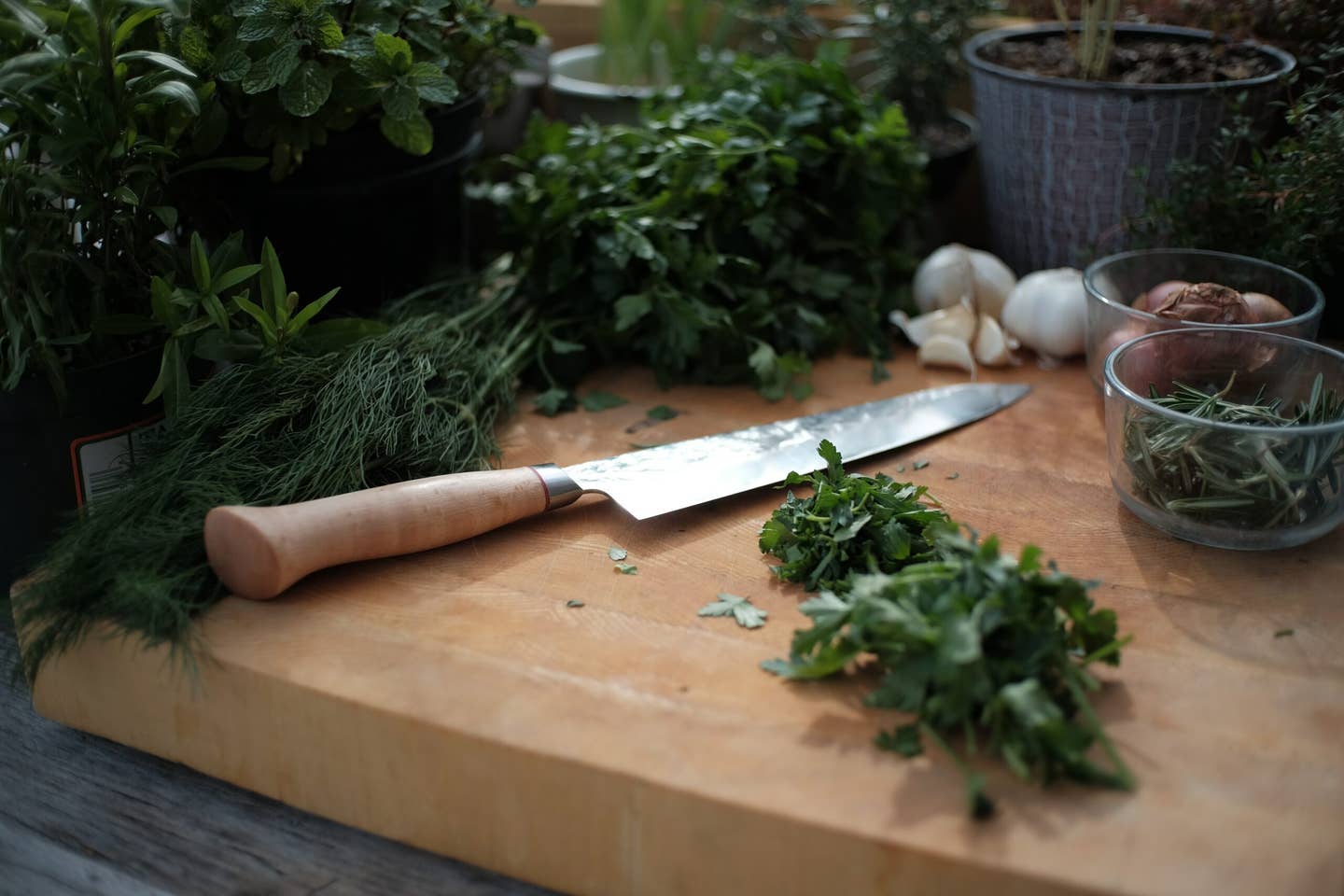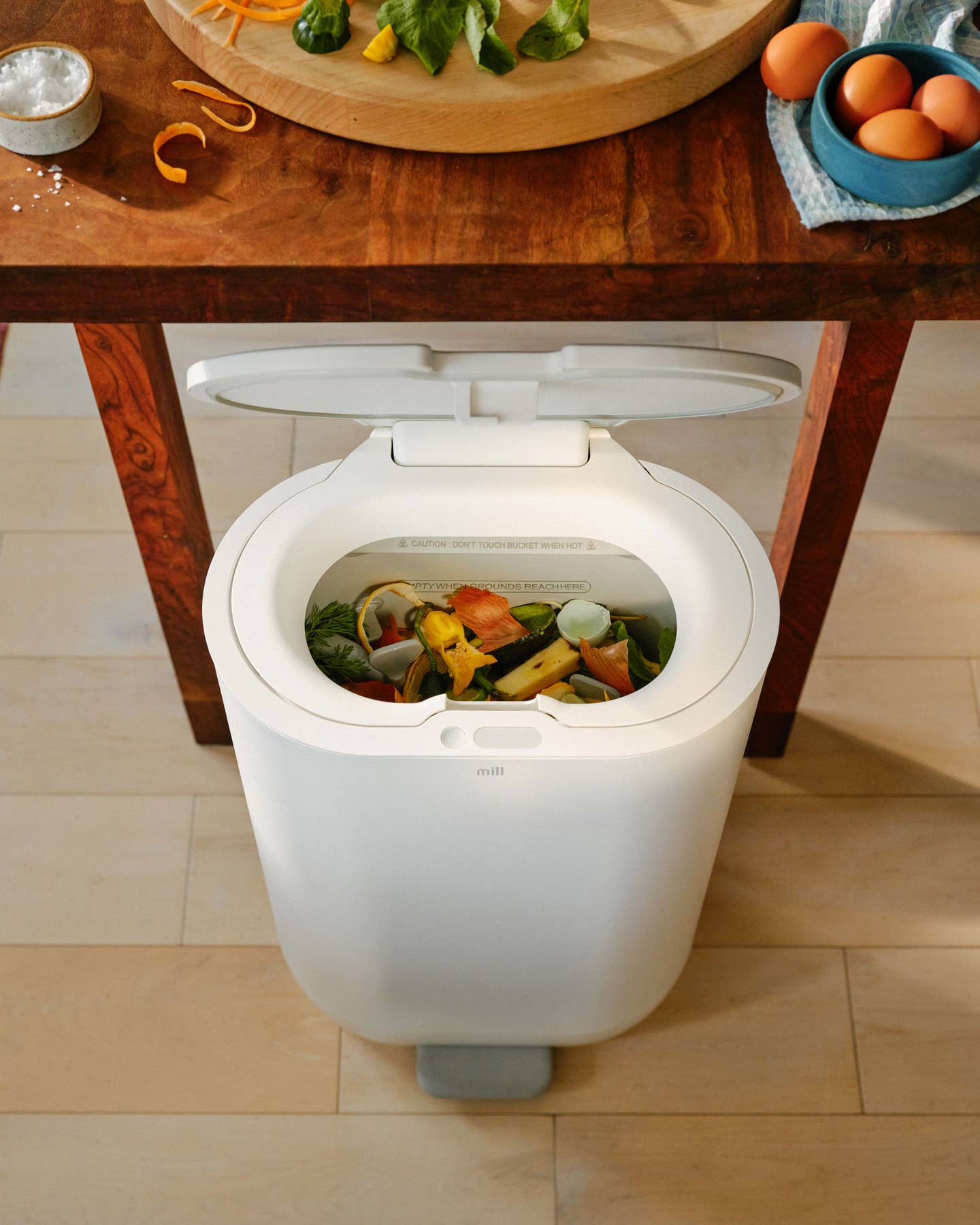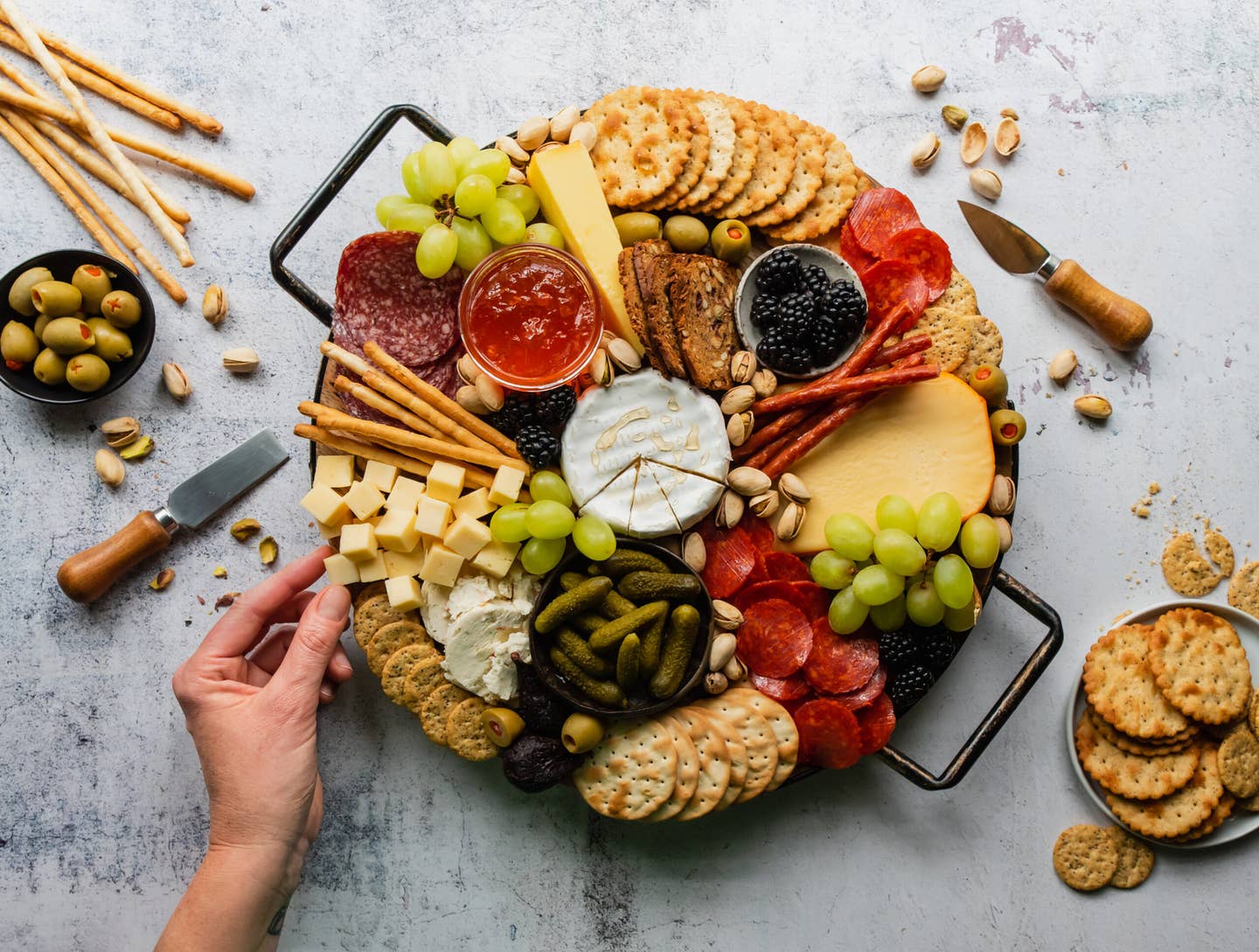
The Next Knife You Buy Should Be a Santoku Knife (+ 9 of Our Favorite Picks)
Make quick work of slicing, dicing, and mincing meat, fish and vegetables.
Much like its better-known cousin the chef knife, the Santoku knife is a versatile workhorse that has a lot going for it. Much, much younger than most Japanese blade-styles, which can carry centuries of history and lore, these youngsters only date back to the mid-1900s. Designed as a multipurpose knife for home cooks, this handy tool has since gained popularity (and is commonly produced) globally. "Santoku" translates to “three virtues,” which can be interpreted in two ways: as reference to its adeptness with meat, fish, and vegetables; or as a nod to its ability to masterfully slice, dice, and mince. Whatever way you slice cut it, this Japanese-style knife is a culinary jack-of-all-trades that's bound to be a kitchen favorite.
Read on for how to pick the best Santoku knife for your cooking needs, skill level, and budget.
- BEST OVERALL: Misen Santoku Knife, $65
- BEST BANG FOR THE BUCK:Mercer Culinary Genesis 7” Santoku Knife, $41
- UPGRADE PICK: Shun Hikari Santoku 7” Knife, $300
- ALSO CONSIDER: HENCKELS Zwilling J.A. Henckels Twin Signature Santoku Knife 7”, $85
- BEST MID-SIZED SANTOKU KNIFE: Mac Knife MSK-65 Professional Hollow Edge 6.5” Santoku Knife, $140
- BEST LIGHTWEIGHT SANTOKU KNIFE: Victorinox Fibrox Pro 7” Santoku Knife, $51
- UPGRADE PICK - LIGHTWEIGHT SANTOKU KNIFE: Global G-48 7” Santoku Hollow Ground Knife, $95
- BEST TRADITIONAL SANTOKU KNIFE: Shun Premier Grey 7” Santoku Knife, $140
- BEST LEFT-HANDED SANTOKU KNIFE: Korin Togiharu Inox Santoku, $119
Before You Buy a Santoku Knife
Before making your selection you’ll want to get a grasp on the finer points that differentiate Santoku knives from chef knives, since they're both wonderfully versatile. First off, both types are fairly mid-sized in contrast to considerably larger (i.e., a bread or carving knife) or smaller options (like a paring knife), but a Santoku knife is the smaller of the two. Additionally, the blade on this knife is quite different: It has a flat cutting edge, which means it doesn’t rock the same way a Western- or European-style knife blade does, and a rounded curve (sometimes called a “sheep’s foot”) at the tip instead of a sharp point.
What to Consider When Buying A Santoku Knife
As with any knife purchase, performance, comfort, stability, and aesthetics are key factors to evaluate. Also think about unique features that you likely will (or definitely won’t) actually make use of and appreciate, such as a storage sheath, self-sharpening abilities, or dishwasher friendliness. Here are some useful factors to get familiar with while shopping for the best Santoku knife on the (butcher) block.
Ergonomics & Handle
Expect to spend a lot of quality time with this blade, so you’ll definitely want to pick a model that feels comfortable and sturdy in your grip. That said, there are a few things to consider: Wood handles, though attractive, are more high-maintenance than plastic, rubber, and composite (i.e. wood-plastic resin blends) models. Totally natural-grain handles don’t weather water exposure well, wear down more quickly, and are prone to bacterial growth. Aside from sanitary and durability considerations, be sure to pick a handle material that you can get a really solid grip on, which may differ from cook to cook. For example, if you often have sweaty palms, a handle with rubber ribs or dots instead of an entirely smooth, slippery-when-wet design is a must.
Blade Material
Traditionally, Santoku knives from Japan are made of Japanese high-carbon steel, the gold standard for most cooks because it’s an extremely hard metal that stays sharp and resists rust and discoloration. But there are plenty of quality knives made of stainless steel, too.
Blade Size and Edge
A Santoku knife is distinctive for its downturned tip and straighter cutting edge (in comparison, a chef knife has a pointed tip and curved cutting edge, positioned at 20 to 22 degrees). Santokus typically have seven-inch blades, but more compact five-inch blades are also common. While longer knives work best for the type of single-stroke cuts you’ll want to make while slicing, the wider, chubbier design of a Santoku knife is preferable for chopping, which entails more of a vertical rocking movement than horizontal sawing.
Blade Design
Santoku blades traditionally have a tsuchime, or hammered, finish that’s dimpled for easy, quick cutting without having to frequently remove food from the blade. Many Santoku knives today sport a more modern, performance-oriented take on this all-over hammered effect, with strategically placed notches (also called grooves, dimples or cullens). These slight depressions let air between the item you're cutting and the blade, which allows for smoother slicing and helps keep food from sticking to the knife—especially useful for juicier items like a ripe tomato.
Tips for Buying and Using Santoku Knives
A Santoku knife is a versatile staple you’ll find yourself reaching for on the regular. Here are a couple more things to mull over:
-
Be mindful of a knife’s construction and care instructions to extend its lifespan.
As with any knife in your arsenal, maintenance needs are unique to the specifics of the knife you’re using, from the blade’s material to the handle’s construction. Some are dishwasher-safe, for example, while others should never be left out wet. Follow the rules. -
Despite its impressive dexterity, don’t use your Santoku knife for everything.
Avoid heavy-duty butchering. As multitalented as a Santoku blade is, it isn’t meant for making contact with bones. Also, for more detailed and delicate knife needs, stick to a more petite paring knife. -
Already have a Santoku knife? Consider adding a second to your knife block.
If you tend to have a few cooks in your kitchen, two Santokus might be better than one. That might mean a budget-friendly backup for that dinner party attendee who’s got minimal knife skills but is eager to pitch in, or two differently sized Santoku knives to accommodate family members with varying hand sizes and grip strength.
Our Top Picks
Now that you’ve got a grasp on the basics, check out our recommendations for a variety of budgets and expertise levels.
BEST OVERALL: Misen Santoku Knife, $65
The crowdfunded, direct to consumer kitchenware company Misen (pronounced “meez-uhn,” as in mise en place) is challenging old-school knife industry stalwarts. Like the brand’s SAVEUR Test Kitchen-vetted chef knife, its Santoku knife is constructed from a steel blend that purportedly contains double the carbon content of its competitors’ knives. The blade measures a slightly longer-than-usual 7.5-inches and features a unique sloped bolster, designed for more comfort and control. Misen offers a 60-day test drive period, plus a lifetime guarantee and free returns, so you’re not stuck with something you don’t love if it just doesn’t make the cut.
BEST BANG FOR BUCK: Mercer Culinary Genesis 7” Santoku Knife, $41
This 7-inch version from Mercer ensures a firm grip even with wet or clammy hands, thanks to its textured handle constructed from Santoprene, a plastic and rubber composite. Its high-quality blade features hollow-ground notches that help reduce friction during use. On the more affordable end, this is also a great option if you’re trying out a Santoku for the first time and don’t want to shell out too much dough.
UPGRADE PICK: Shun Hikari Santoku 7” Knife, $300
Fancy in both form and function, this Santoku knife from high-end Japanese brand Shun’s Williams Sonoma collection has impressive details. Unlike the fully flat blade edge of a traditional Santoku knife, the Hikari has a slightly curved edge that rocks a bit (more like a Western-style knife), making swift work of finely chopping herbs or mincing ginger. Its curved birch Pakkawood (a composite wood and plastic) handle feels comfortable and works well for various hand sizes. The damascus patterning on the blade isn’t just there for its good looks: layered over alternating microlayers of stainless steel, it’s designed to provide some texture, preventing foods from sticking during cutting and also purportedly wears at different rates by creating "micro serrations" that extend performance between sharpenings.
ALSO CONSIDER: Zwilling J.A. Henckels Twin Signature Santoku Knife 7”, $85
Though not the least expensive on this list, well-regarded staple from German brand Henckels is still nearly half the cost of many top-reviewed Santoku knives. Its stamped seven-inch blade is constructed from Henckel’s signature high-carbon steel and hardened in ice, a finishing flourish that purportedly makes for a sharper, stronger, longer-lasting blade. Ovaline notches on each side of the blade, in place of the Santoku’s classic hammered tsuchime finish, ensure the knife won’t drag. The full-tang design is also triple riveted and features a curved polymer handle.
BEST MID-SIZED SANTOKU KNIFE: Mac Knife MSK-65 Professional Hollow Edge 6.5” Santoku Knife, $140
Most Santoku knives are 5- to 7-inches long, but at 6.5-inches, this falls in between.
This model from the professional line of Japanese brand Mac has a comfortable, attractive Pakkawood handle. The sharp, 6.5” blade features a Granton edge, so it makes cleaner, quicker cuts. Plus, it’s easy to sharpen. It is on the heavier side for a Santoku knife, though, weighing in at 9.6 ounces, so it’s probably not the best fit for particularly petite hands.
BEST LIGHTWEIGHT SANTOKU KNIFE: Global G-48 7” Santoku Hollow Ground Knife, $95
Global’s Santoku knife weighs a very slight 3.2 ounces despite its standard seven-inch blade. The blade of these innovative knives, produced in the Japanese city of Niigata, are made from CROMOVA 18, Global’s proprietary steel blend that includes molybdenum, vanadium, and chromium. In layman's terms, this blade stays sharp for a long time and resists rust or corrosion; it's far more durable than blades forged from traditional Japanese steel.
BEST BANG FOR THE BUC: Victorinox Fibrox Pro 7” Santoku Knife, $51
This Santoku knife from Swiss brand Victorinox has a Granton-edged blade similar to our Mac Professional pick, but at 4.6 ounces, it’s significantly lighter in weight (plus an extra half inch of length) due to a blade that’s stamped, not forged. The handle is constructed from Victorinox’s patented thermoplastic rubber material, makes it easier to grip, and more comfortable. The low-priced pick is also low-maintenance: Online reviewers say it's easy to sharpen and is dishwasher safe.
BEST TRADITIONAL SANTOKU KNIFE: Shun Premier Grey 7” Santoku Knife, $140
This handcrafted option from Japanese brand Shun sports the classic hammered tsuchime-finished blade. Less expensive than our Upgrade Pick from the brand, it’s still a considerable investment, though it is so striking that you’ll want to show it off instead of stowing it away.
BEST LEFT-HANDED SANTOKU KNIFE: Korin Togiharu Inox Santoku, $119
A SAVEUR Test Kitchen favorite, this classic santoku is designed for working with both proteins and vegetables. The thin, razor-sharp blade sweeps through most foods easily, though you will want to avoid hitting bone, which could chip the hardened steel. And because its 70/30 beveled edge is, by nature, sharper and more precise than symmetrically beveled blades, it’s not an ambidextrous knife. For left-handed folks tired of wrestling with tools made for righties (or that falsely promise to be compatible with either dominant hand) this is a good thing. Just be sure to specify when ordering if you need a left-handed knife.
FAQs About Santoku Knives
So you’ve scooped up a standout Santoku knife. Congrats! Here's what else you need to know:
Q. How do I clean my Santoku knife?
Most knives, Santoku or not, are best hand washed with mild soap and warm water immediately after use, then fully dried promptly after washing. Only knives that are explicitly labeled as dishwasher-safe should ever get machine-cleaned!
Q. Are Santoku and chef blades the same size?
No, a Santoku knife’s blade is typically 5” or 7”, which is smaller than the 6” to 14” range of most chef’s knives, with most home cooks opting for the 8” chef knife.
Q. Besides a Santoku knife, what other knives do I need?
It totally depends on your needs. Many consider this a solid alternative to a chef's knife, and here are some of our other tried-and-true favorites.
Keep Reading
Continue to Next Story










